The second day in Iran was the worst for me. It started with a poor choice of clothes. My yellow, shear, short-sleeved vintage shirt with mother-of-pearl buttons is one of my favorite warm weather shirts. But I didn’t realize how see-through it was until I wore it in the Islamic Republic of Iran, where men aren’t allowed to wear shorts or go shirtless and women must cover arms and legs and wear scarves. I didn’t think the fact that the shirt had only four buttons was a big deal until I wore it in 30-mile-an hour winds. I was on my way to the holy Imam Khomeini Shrine and all-of-the sudden I was showing more belly button than Madonna.
As I was trying to keep my shirt from blowing off or ripping we ducked into a little shop to get some water. It was there that I saw one of the most unusual sights in my entire two weeks in Iran: a Thomas Kincade print.
We resumed our march toward the shrine, a massive mosque in the middle of an arid plain south of Tehran—still not complete after twenty years of work—when a tall lanky man approached. In broken English he asked if we were American. Yes we were. “Bush good? Bush bad?” he asks. Before we could answer he says “Bush baaaad.” Then again; “Obama good? Obama bad? Obama baaaaad.” He chuckles to himself and our guide Houman shoos him away.
I did not realize it at the time but that brief verbal sucker-punch was the zenith of the hostility we would receive from Iranians. For the remainder of the two weeks we could hardly coax a bad remark about America from anyone we encountered, and we certainly could find no shortage of people who were delighted to discover we were Americans. If we had accepted every invitation we received for tea or a meal we would still be there, and not ready to leave anytime soon.
When friends discovered I was spending a year-and-a-half of my life in prep and a good chunk of savings for my son and I to visit Iran there were many raised eyebrows as supportive high-fives. Skepticism usually sounded like this; “So. Why Iran?”
The short answer is because I have a good friend who is Persian and I have a unique opportunity to visit an exotic locale with someone who grew up there. The long answer is that I am part of a peace delegation on a mission to plant a peace tree to help improve knowledge and understanding between two countries with deep governmental hostility, which, I believe, can best be achieved through direct interaction between individuals, absent of sponsoring organizations and government involvement. There is one more answer that I could not have anticipated before I left. The Iranian people love meeting and talking to Americans so much that this rare social interaction is reason enough to travel to Iran.
The payoff to visiting Iran is huge. If you love the great outdoors, hiking, climbing, cycling, and conservation there’s a whole universe to discover. But the obstacles to visiting aren’t small.
In order for an American to visit the Islamic Republic of Iran you need to obtain a visa. It is best to have an Iranian citizen in Iran to help assist you with this process and you must work with a licensed tour guide. The Iranian government is taking some steps to boost tourism but they have a long way to go. Iran is a country of 70 million people about the size of Alaska yet it officially only has around million tourists every year. Our guide insisted the actual number of tourists is only around 250,000. While Americans have the most difficulty reaching Iran because of our embargo, it’s not that easy for other countries either, otherwise the numbers would be higher. For comparison, just the state of California hosts 14.4 million foreign tourists annually.
When in Iran the American traveler faces some difficulties not found in other foreign countries. Your credit cards are worthless there. No bank that you do business with does business in Iran. That means the only money you have is what you bring with you. It’s best to bring post 1996 hundred dollar bills for the best exchange, which you will have to do on the street. No Iranian bank will take American money. You have to turn in your passport at every hotel you stay at. You are not supposed to go anywhere without your guide and your guide must submit your itinerary to the government. Under no circumstances are you allowed to stay in private homes.
We broke this last rule a couple times. My traveling companions, Pam, Tom, and their nine-year-old son Zach, and my son Jackson and I stayed in private homes for several days during our trip and got away with it. It was a great chance to meet average Iranians and see how they lived. (Not that much different than us).
CYCLING
I like riding bikes in big city traffic, but the dense auto-anarchy of Tehran’s 14 million inhabitants will challenge any urban commuter’s sense of adventure. Cars are smaller here and they pack about 5 times as many of them per road as in the U.S. All traffic signage is advisory, not compulsory. I saw cars running red lights, straddling lane lines and even going the opposite direction on one-way street. Driving a car there is just one carefully controlled game of chicken. Imagine walking out into an 8-lane arterial with 40-mile-an-hour traffic and just walking until cars clip you or decide to stop. That’s crossing the street in Tehran. In Iran all the marginal edges of the road that might house bicycles in the U.S. are filled with the countries most popular form of transportation—the 125cc motorcycle. The small motorbike takes the place of a lot of bicycle transportation primarily because it can carry three or four people at a time—not an uncommon site. The few bicycles I saw in Tehran were moving carefully.
When we were in cities that were smaller and farther south I saw more bicycles. Outside the extreme traffic density of Iran they make more sense, with their low operating cost and ability to park anywhere. That’s important because there’s hardly a surface parking lot in the entire country. Almost all stores are 2,000 square feet or less and don’t accommodate cars. Most cars on the road are official or unofficial taxis. The bikes fall into two main categories: cheap late-model Chinese mountain bikes and tank-like double-tube Phoenix bicycles.
Outside the cities, Iran seems like a bicycle touring dream. Amazing natural scenery from mountains, deserts, rainforest, and coastline combined with a wide variety of archeological sites that range from hundreds to thousands of years old. You can pitch a tent wherever, but the Iranian commitment to guests and hospitality means that the chances are high that bicycle tourists will be invited in for tea, a meal, or a night indoors.
HIKING
One morning we were hiking in the mountain village of Abyaneh which was like being on Mars. We were surrounded by bright red rock in sharp and brittle formations. We kept discovering new wildflowers and trails leading to ancient sheep shelters built into the hills, and in the distance I could see a patch of snow in the mountains above a 400-year-old brick fort. I remember thinking I could hike here for a week and still discover news things. I felt the same way when we hiked to the top of a 600-foot sand dune and also in the foothills north of Tehran. Iran seems filled with amazing hiking opportunities. If you think the country is one big sand flat you are in for a big surprise.
The combination of hiking and archeology is potent too. Persopolis is such a sprawling complex of ancient architecture that it offers a hike unto itself. The tombs of Darius and Xerxes are beautifully carved in the mountainside and the tomb of Cyrus the Great is also impressive. These sites are thousands of years old, but the country has countless sites that are merely hundreds of years old. It’s easy to wonder why ancient Persian history hasn’t captured our imagination the way Egyptian and Greco-Roman history has. Maybe we just need a few good movies.
The only thing disappointing about hiking in Iran is the inevitable garbage. The ethic of packing in and packing out just doesn’t exist for the average Iranian. People here don’t see litter as a problem. But that may change as a younger generation become more interested in the environment and tourism expands.
CLIMBING
Driving through the country I was amazed by the frequency and variety of rock formations. What would it be like to climb that, or that, or that? Nasim, of Nasim and Jafar, the two Iranian cyclists who visited Spokane last year on their mission to ride their bikes and plant peace trees all over the world, was also once the leader of the Iranian Women’s National Climbing Team. She told me there all sorts of great climbing in the country, including a large face in south Iran that climbers come from all over the world to scale. There are two major mountains ranges—Alborz and the Zagros—and you can find guide services that will lead climbing tours of each.
Iran’s capital, Tehran, is a terrific place to be a rock climber. The mountains north of town offer great access to a variety of climbs. We saw men and women climbing ambitious routes, just like a summer day at Minnehaha. As you ascend high into the mountains, where the good climbing is, you also reach more freedom than one has in the city. Men can be seen wearing shorts, women
wear less modest athletic gear, and the conversation is more free and easy without the threat of a reproach from authorities.
Then there is Damavand. This mountain is an active volcano a few hours northeast of Tehran. It is 18,600 feet high, over 4,000 feet higher than Mt. Ranier. It’s the highest mountain in the Middle East and is a favorite climbing destination. But it also fun if you just want harvest volcanic mint and have some trout for lunch.
CONSERVATION
On our first night in Iran we ended up playing volleyball and sharing cupcakes with a group of young adults involved in Save The Cheetahs organization. The Iranian Cheetah is a rare species on the edge of extinction with only about 150 specimens remaining in the wild. Save the Cheetahs specializes in documenting and protecting the cheetahs with heat/motion sensing cameras and also educating people in remote locations not to kill the animals. This group seemed emblematic of conservation in Iran. If they can align the cheetahs with Persian pride perhaps it can help the entire country look at the natural environment in a new way. Further steps would be planning for sustainability and littering a lot less.
But the country isn’t exactly missing the conservation boat. In Tehran there is a major PR campaign to get people to use compact fluorescent bulbs, and indeed we saw CF bulbs everywhere.
THE CITIES
I found the mix of antiquity and modern impulses in Iranian cities dazzling. The men seemed to all dress better than me, with an Iranian twist on European fashion. You could go inside a 400-year-old bazaar and get the latest men’s wear right next to piles of fresh spices. One minute I was buying music from Afghan refugees and the next I was visiting an enormous mosque with exquisite blue tiling. And everyone wanted to talk. When they find out you are American the first thing the say is “Welcome to our country.” We love visiting your country, I would say. Now where can I find a shop that sells Iranian National Team World Cup jerseys?
The one thing that impresses me most about visiting Iran is the hospitality of the people. All we needed was a soccer ball and a sideways glance and we were making friends in the park. People we met wanted to give us gifts. They invited us to meet their families. They cooked amazing meals for us. They wanted to take our picture. One taxi driver was so happy to give a ride to the rare American visitor that he wouldn’t accept payment, even though we were very insistent. Our hosts rearranged their lives so we could have the best trip possible. At one of the apartments we stayed at the young gentleman made us breakfast everyday. When I tried to offer him money he recoiled like I was trying to poison him.
The same day that I had a rough time visiting the Imam Khomeini Shrine I was feeling tired and run down on the crowded subway back to town. I looked across the car at a man who was old enough to be my grandfather, in very modest clothes and well-worn shoes. He saw me and smiled and then offered up his seat to me. I politely declined. This memory stays with me. It is the real Iran, a place I would like to visit again.
Written by Jon Snyder, founder of Out There Outdoors magazine. Jon served on Spokane’s City Council while publishing Out There, and now lives in Olympia, Wash., where he works as Senior Policy Advisor for Outdoor Recreation and Economic Development for Governor Jay Inslee.













